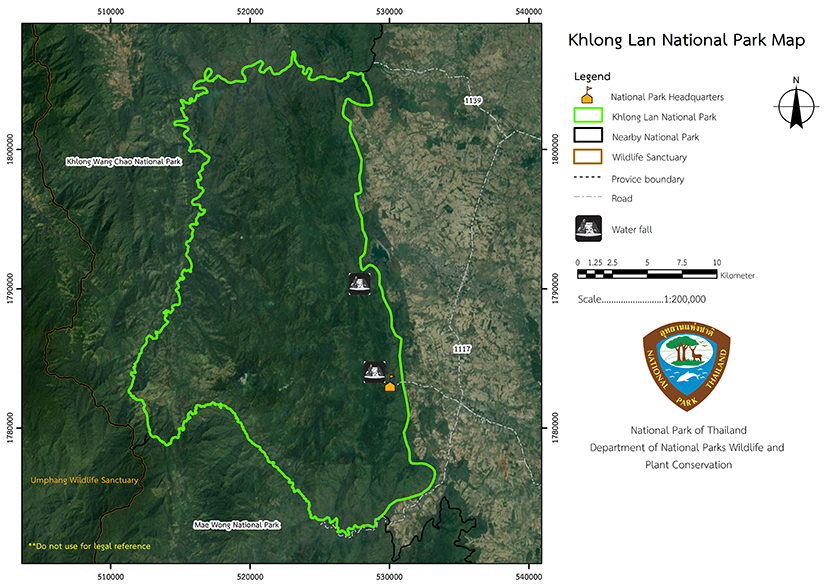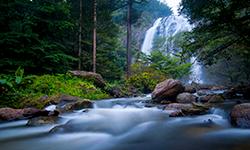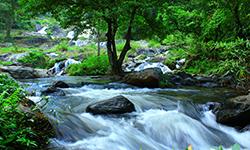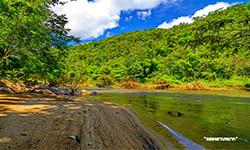Khlong Lan National Park
Contact Location : Khlong Lan National Park, Khlong Lan District, Kamphaeng Phet Province 62180
Telephone Number : (+66) 8407 9915
Email : khlonglan_np@hotmail.com
Facebook : Khlong Lan National Park
Information
Khlong Lan National Park is located in Pong Nam Ron, Khlong Nam Lai and Khlong Lan Phatthana Sub-district, Khlong Lan District in Kamphaeng Phet Province. It is approximately 187,500 Rai, or 300 square kilometers.
Background
The Royal Forest Department issued order 192/2523 on January 28th, 1980, to Mr. Preecha Chansiritanon, Forest Officer Level Four, to survey and organize the Khlong Lan forest in Kamphaeng Phet Province as a National Park. The area is a fertile teak and other hard woods forest .mountainous terrain with magnificent natural scenery. A forest upstream would be the ideal location for a National Park.
Royal Forest Department was presented to the National Park Board and On June 15th 1982, adopted the resolution. A royal decree designating the Khlong Lan forest area as a National Park was deemed appropriate, and the department designated the Khlong Lan forest area in the Pong Nam Ron, Khlong Lan and Khlong Lan Phatthana Sub-district, and Khlong Lan District, Kamphaeng Phet Province as a National Park on December 25th,1982. It was the country's 44th National Park.
Note : After paying the entrance fee to the National Park, please carry the receipt for inspection.
187,500.00 rai
|
|
|
|
|
Nature trails ⇔ Visit Waterfall ⇔ Forest Viewpoint ⇔ Bird , Butterfly ⇔ Camping
Welfare shop : Open daily from 8.30 – 16.30 hrs.
National Park Headquarters : AIS, TRUE, DTAC
|
|
There is a plain with a simple sandy loam soil. Each mountain is connected to Khun Khlong Lan, the area's highest summit at 1,439 meters above sea level. Upstream, there is a forest, and numerous rivers originate here before traveling to the Ping River, including the Khlung Canal and the Suan Mak Canal.
|
|
|
The National Park's Climate: Throughout the year, the average temperature is around 27 degrees Celsius butsummer days are extremely hot. In April, the maximum temperature can reach 38 degrees Celsius, yet in winter it may drop as low as 17 degrees Celsius in December. There is a lot of rain during the rainy season, with total annual rainfall at 1,300 millimeters.
|
|
|
|
|
Dry Evergreen Forest: This type of forest is generally found at an elevation of approximately 500 meters above sea level and it is home to Hopea odorata, Hopea ferrea Laness, Tetrameles, Toona ciliata, Shorea, and Beleric Myrobalan. Mixed Deciduous Forests cover 13.33%of the National Park's total area. mixed deciduous and tropical evergreen forest ,covering 35.60% and other primary wood species including Burma Padauk, Teak, Lagerstroemia calyculata Kurz , Black Rosewood, and various bamboo species. Other Forest types, such as Deciduous Dipterocarp Forest, can be found between 400 and 600 meters and have dominant tree species such as Burma Sal, Shorea siamensis, Morinda coreia, Beleric myrobalan, Terminalia alata Heyne, and Tetrameles nudiflora R.Br., Bamboo is common in a number of varieties and grows in patches, and certain areas have grassy forests. Wildlife: Threats to wildlife include smooth-haired otters (L. perspicillata), Viverricula ndica The survey noted a total of 82 bird species classified into 27 families. Table 2 in the Appendix contains additional information. 17.03% or 14 bird species are highly abundance, 80.49% or 66 species are moderately abundance, 2.44% or 2 species are less abundance. There is no bird species in vulnerable or endangered categories, considering the population size, habitat, and threat factors. There are 26 amphibian species found in 5 families (details shown in Annex's Table 3). 23.08% or 6 species are highly abundance, 50% or 13 species are moderately abundance, 26.92% or 7 species are less abundance, and 46.15% or 12 species are endangered. On the basis of population the Smith's Litter Frog (L.hasselti), Martens's Puddle Frog (P. martensi), Rugosed Frog (R.rugulosa), and P.parvulusaccounted for 23% of total amphibians. Amphibians threatened with extinction (endangered species) were at risk because of their small population size, habitat destruction, and predators, including the Northern Tree Frog (R.leucomystax), Ornate Narrow-Mouthed Frog (M.ornata), R.livida, and Rice Field Frog (R.limnocharis). There are 35 reptile species found in 11 families (details shown in Annex's Table 4). 2.86% or 1 species are highly abundance, 68.52% or 24 species are moderately abundance, 28.57% or 10 species are less abundance, and 31.43% or 11 species are endangered. on the basis of population he animals include the Orange-headed Temple Terrapin (H. grandis), Asian Forest Tortoise (M. emys), Blanford's Flying Lizard (D. blanfordi), and the Ground Lizard (L. belliana), among others. 25.74 % of the animals surveyed, or 9 species are threatened with extinction (Vulnerable species) on the basis of population including the Elongated Tortoise (I.elongata), the Flat-Tailed House gecko (C.platyurus), and the Eutropis macularia (M.maculania) There were 30 freshwater fish species identified in 11 families, the majority of which were Cypridae members, such as Danio (D.regina), Silver rasbora (R.trilineata), and Greater Brook Carp (T.tambroides) |
How to get there by car :
Travel by car from Bangkok is along the Asian Highway through Nakhon Sawan Province. At milestone No. 307, just before reaching the city of Kamphaeng Phet, turn left onto Route 1242 through the Pang Silathong District. At Khao Nam Aun there are three intersections, where you should turn right onto Route 1072 and proceed to the Khlong Lan Market intersection. Drive another 4 kilometersto the Khlong Lan National Park Headquarters.
To reach the waterfall, drive along the Asian highway through Nakhon Sawan Province to milestone No. 346 in Kamphaeng Phet where you bear left onto Sai Khlong Road at Ban Khlong Mae Lai market. At Mae Lai - Um Phang take the intersect on the right-hand side, 46 kilometers from the Khlong Lan market intersection. After that, it's another 4 kilometers to the Khlong Lan National Park headquarters, which is located near the Khlong Lan Waterfall.
- National Park Ranger Station Kho Lo No. 1 (Mae Phut)
- National Park Ranger Station Kho Lo No. 2 (Khlong Nam Lai)
- National Park Ranger Station Kho Lo No. 3 (Phet Cha Kho)
- National Park Ranger Station Kho Lo No. 4 (Khlong Suan Mak)
- Khlong Lan 107 (Chan Pha)
- Khlong Lan 108 (Fa Mui)
- Khlong Lan 109 (Si Suk)
- Khlong Lan 110 (Cha Thong)
- Khlong Lan 114 / 1-4 (Thao Wan Piang)
- Khlong Lan 115 / 1-4 (Maniangnam)




